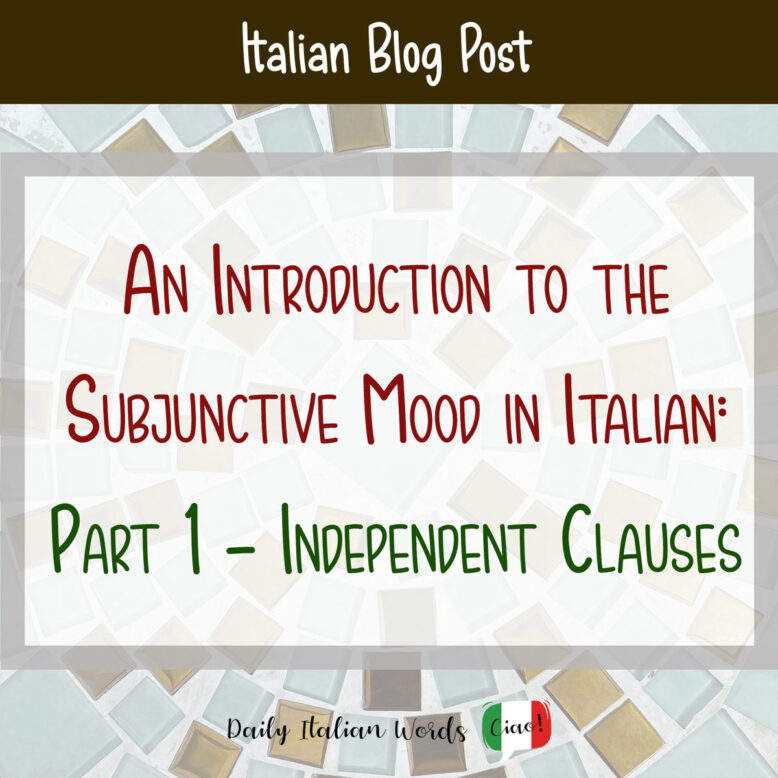Chi ha paura del congiuntivo? Who is afraid of the subjunctive mood? Many, it seems, judging by the rivers of ink spilt on the subject. The debate ‘subjunctive or no subjunctive’ also found its way into television programmes, and for years now the refrain ‘the subjunctive is dead’ has been heard at conferences and in newspapers, so much so that we may end up thinking that Italians no longer know how to speak their language properly. Or do they?
Actually, the subjunctive is not in such a bad shape. On the contrary, it is alive and kicking, sparkling and full of vitality. Just try to type an incorrect subjunctive phrase on social media, and you will be instantly inundated with criticism, from smiles of contempt to outright insults.
So where does the truth lie? The bottom line is that it’s not all black and white, so do not think of it as a battle between the forces of evil, where sinister individuals mistreat the subjunctive, and the forces of good, the knights of grammatical purity, who will defend the integrity of our language to the death.
While it is certainly true that the use of the subjunctive has decreased over time as a consequence of overall language simplification, it is also true that Italians still have a strong sense of what is grammatically correct and what is not — sometimes even a bit too strong!
To return to the original question, nobody fears the subjunctive, and neither should you!
So how do you navigate the seeming complexity of this verbal mood? Once you have digested the grammatical rules — sorry, there is no way around them, you have to learn them! — what helps you understand why some speakers use the subjunctive and others do not is their language register, i.e. their way of speaking or writing, the level of expression appropriate to a given communicative situation, which is linked both to the socio-cultural background of the speaker and to their communicative purpose.
The range of language registers in Italian is very wide, even leaving aside regional varieties, and in recent years, communication through technology has contributed to the spread of informal and lower registers in writing, too. For instance, very low registers are sometimes used by youth groups as a mark of their social identity, where the use of the subjunctive would be ridiculed, whereas professionals in a law firm are obviously expected to communicate in formal and competent Italian.
In the adventures of the extraordinary Ragionier Fantozzi, one of the most representative comic characters of Italian cinema, people are often characterised in a comic key by their incorrect use of the subjunctive. All Italians remember Ragionier Filini and his grammar mistakes with a smile: ‘Venghi, Fantozzi! Venghi!’
In the end, the subjunctive or no subjunctive question is a false problem, and anyone who loves our beautiful language should embrace this mood as a dear friend.
The subjunctive — il congiuntivo — is often used in dependent clauses, as the name suggests: the word congiungere means to join, to unite, and this mood often joins a dependent clause to a main clause. For example: Io credo che questo libro sia tuo. Io credo, I believe, indicative, is the main clause, while che questo libro sia tuo, that this book is yours, is our dependent clause. Sia is subjunctive, third person singular of the verb essere, to be.
The use of the subjunctive in dependent clauses is determined by the verb in the main clause, the type of dependent clause and by the use of specific phrases before the verb; but you don’t have to worry about that now, because today we’ll focus on its use in independent clauses. Many common expressions employ this mood to communicate an additional layer of meaning that is missing from the simple indicative mood.

Dubbio desideri, esclamazioni, comandi? Congiuntivo!
1. In general, we can call the subjunctive the mood of uncertainty. If we have a doubt, we can express it with the subjunctive, in the present or past tense:
La macchina non parte, che sia rotta?
The car won’t start, could it be broken?
I ragazzi sono in ritardo, che abbiano perso il treno?
The kids are late, maybe they missed the train?
WATCH OUT: we can also express a doubt with the indicative, but in this case we must add the word forse, maybe:
I ragazzi sono in ritardo, forse hanno perso il treno?
La macchina non parte, forse è rotta?
2. We use the subjunctive to make a wish, using the imperfetto to express a wish for present or future and the trapassato to express a past wish that has not been fulfilled:
Se vincessi alla lotteria!
How I’d love to win the lottery!
Se almeno avesse detto la verità!
If only he/she had told the truth!
In this kind of sentences we often use expressions such as magari, almeno, volesse il cielo che, se solo.
3. The subjunctive is also used as an exclamation. We use the imperfetto if the exclamation is in the present tense, and the trapassato if the exclamation is in the past tense:
Sapessi come sono felice!
If you only knew how happy I am!
Avessi visto che panorama!
You should have seen the sight! / If only you had seen the sight!
These exclamations can be preceded by the word se (if), but it is not mandatory.
4. Finally, we use the subjunctive to give an order, a command, an exhortation, an invitation in the third person singular, first and third person plural (he/she; we; they). It is also used with the courtesy form.
With the third person singular and plural, the verb can be preceded by the word che (that), but this is optional.
Che vengano pure!
Let them come! / Sure they can come!
Che ci provino!
Let them try!
- Entri pure, signorina! = Come in, miss!
- Dia il buon esempio! = Set a good example!
- Abbia pazienza! = Be patient! (courtesy form)
- Viva l’Inghilterra! = Hurrah for England!
I will leave you with this famous ad for chocolates, which includes a play on words: baci means kisses (also the name of the chocolates) but it is also an exhortation: Those who love, kiss!
And the next time you say Viva l’Italia, remember: you are using the subjunctive!
I tempi del congiuntivo – The subjunctive tenses
The subjunctive mood includes four tenses: presente, imperfetto, passato, trapassato (present, imperfect, perfect, pluperfect). Cheer up! In the present subjunctive of all three conjugations, the first, second and third person singular are the same, and the first person plural is the same as the present indicative.
Prima coniugazione – First conjugation
| PRESENTE | PASSATO | |
| CHE IO | AMI | ABBIA AMATO |
| CHE TU | AMI | ABBIA AMATO |
| CHE LUI/LEI | AMI | ABBIA AMATO |
| CHE NOI | AMIAMO | ABBIAMO AMATO |
| CHE VOI | AMIATE | ABBIATE AMATO |
| CHE LORO | AMINO | ABBIANO AMATO |
| IMPERFETTO | TRAPASSATO | |
| CHE IO | AMASSI | AVESSI AMATO |
| CHE TU | AMASSI | AVESSI AMATO |
| CHE LUI/LEI | AMASSE | AVESSE AMATO |
| CHE NOI | AMASSIMO | AVESSIMO AMATO |
| CHE VOI | AMASTE | AVESTE AMATO |
| CHE LORO | AMASSERO | AVESSERO AMATO |
Seconda coniugazione – Second conjugation
| IMPERFETTO | TRAPASSATO | |
| CHE IO | CREDESSI | AVESSI CREDUTO |
| CHE TU | CREDESSI | AVESSI CREDUTO |
| CHE LUI/LEI | CREDESSE | AVESSE CREDUTO |
| CHE NOI | CREDESSIMO | AVESSIMO CREDUTO |
| CHE VOI | CREDESTE | AVESTE CREDUTO |
| CHE LORO | CREDESSERO | AVESSERO CREDUTO |
Terza coniugazione – Third conjugation
| PRESENTE | PASSATO | |
| CHE IO | SENTA | ABBIA SENTITO |
| CHE TU | SENTA | ABBIA SENTITO |
| CHE LUI/LEI | SENTA | ABBIA SENTITO |
| CHE NOI | SENTIAMO | ABBIAMO SENTITO |
| CHE VOI | SENTIATE | ABBIATE SENTITO |
| CHE LORO | SENTANO | ABBIANO SENTITO |
Links to our videos on the subjunctive mood:
The subjunctive in independent clauses
The subjunctive in dependent clauses
The subjunctive used with conjunctions
My Italian Circle is a place where you can go to find engaging new ways to learn Italian, test and improve your listening skills, and maybe even make peace with Italian grammar. We create clear, accurate, authentic content every week on YouTube and Patreon.

Anna is a professional language teacher and Diana is a freelance translator. On their website and YouTube channel My Italian Circle, they create content for Italian learners, especially English speakers. They help with grammar, progression from beginner level, and offer insights into authentic everyday Italian, Italian culture, and lifestyle.


